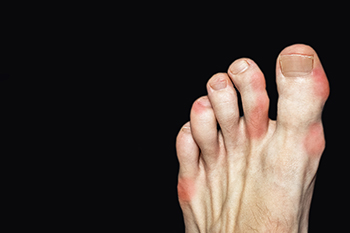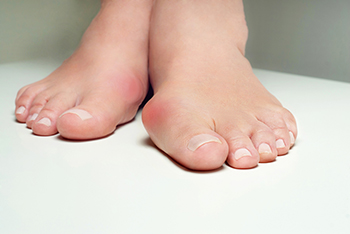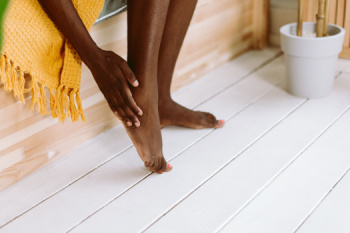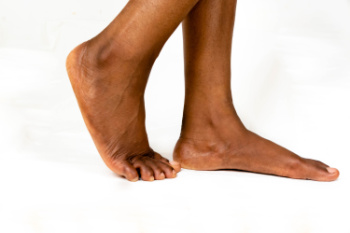Items filtered by date: July 2024
Signs and Causes of Gout

Gout, a type of arthritis, causes sudden, intense joint pain, often affecting the big toe initially. The affected joint becomes swollen, red, and tender to the touch during gout attacks. This condition arises from an accumulation of uric acid crystals in the joints, stemming from an overproduction or inefficient excretion of uric acid in the body. Dietary factors such as high-purine foods like red meat, seafood, and alcohol consumption can worsen gout attacks. Diagnosis typically involves a thorough medical history review, physical examination, and possibly joint fluid analysis to detect uric acid crystals. Blood tests measuring uric acid levels also aid in diagnosis. If you have had one or several gout attacks, it is suggested that you are under the care of a podiatrist who can offer you relief options and help you to manage this condition.
Gout is a painful condition that can be treated. If you are seeking treatment, contact Priyanka Mude, DPM from North Canton Podiatry. Our doctor will treat your foot and ankle needs.
What Is Gout?
Gout is a form of arthritis that is characterized by sudden, severe attacks of pain, redness, and tenderness in the joints. The condition usually affects the joint at the base of the big toe. A gout attack can occur at any random time, such as the middle of the night while you are asleep.
Symptoms
- Intense Joint Pain - Usually around the large joint of your big toe, and it most severe within the first four to twelve hours
- Lingering Discomfort - Joint discomfort may last from a few days to a few weeks
- Inflammation and Redness -Affected joints may become swollen, tender, warm and red
- Limited Range of Motion - May experience a decrease in joint mobility
Risk Factors
- Genetics - If family members have gout, you’re more likely to have it
- Medications - Diuretic medications can raise uric acid levels
- Gender/Age - Gout is more common in men until the age of 60. It is believed that estrogen protects women until that point
- Diet - Eating red meat and shellfish increases your risk
- Alcohol - Having more than two alcoholic drinks per day increases your risk
- Obesity - Obese people are at a higher risk for gout
Prior to visiting your podiatrist to receive treatment for gout, there are a few things you should do beforehand. If you have gout you should write down your symptoms--including when they started and how often you experience them, important medical information you may have, and any questions you may have. Writing down these three things will help your podiatrist in assessing your specific situation so that he or she may provide the best route of treatment for you.
If you have any questions, please feel free to contact our office located in North Canton, Ohio . We offer the newest diagnostic and treatment technologies for all your foot care needs.
See Your Foot Specialist Regularly If You Work On Your Feet
How to Manage an Ingrown Toenail

Ingrown toenails occur when the edge of the nail grows into the surrounding skin, leading to redness, swelling, and tenderness, often causing incredibly painful. Common causes include improper trimming, wearing tight footwear, or injury. Symptoms may worsen if left untreated, potentially leading to infection. Initial treatment involves soaking the affected foot in warm water and gently lifting the nail edge with a clean instrument to reduce pressure. Avoid cutting the nail yourself, as this can invite infection and make it worse. Wearing comfortable shoes and practicing proper nail care can help to prevent recurrence. For persistent pain, signs of infection like pus, or increased redness, it is important to consult a podiatrist. They can provide professional care, including minor surgical procedures to remove the ingrown portion of the nail and prevent future problems. If you have an ingrown toenail, It is suggested you schedule an appointment with a podiatrist for an expert evaluation and tailored treatment plan to alleviate ingrown toenails effectively.
Ingrown toenails may initially present themselves as a minor discomfort, but they may progress into an infection in the skin without proper treatment. For more information about ingrown toenails, contact Priyanka Mude, DPM of North Canton Podiatry. Our doctor can provide the care you need to keep you pain-free and on your feet.
Ingrown Toenails
Ingrown toenails are caused when the corner or side of a toenail grows into the soft flesh surrounding it. They often result in redness, swelling, pain, and in some cases, infection. This condition typically affects the big toe and may recur if it is not treated properly.
Causes
- Improper toenail trimming
- Genetics
- Improper shoe fitting
- Injury from pedicures or nail picking
- Abnormal gait
- Poor hygiene
You are more likely to develop an ingrown toenail if you are obese, have diabetes, arthritis, or have any fungal infection in your nails. Additionally, people who have foot or toe deformities are at a higher risk of developing an ingrown toenail.
Symptoms
Some symptoms of ingrown toenails are redness, swelling, and pain. In rare cases, there may be a yellowish drainage coming from the nail.
Treatment
Ignoring an ingrown toenail can have serious complications. Infections of the nail border can progress to a deeper soft-tissue infection, which can then turn into a bone infection. You should always speak with your podiatrist if you suspect you have an ingrown toenail, especially if you have diabetes or poor circulation.
If you have any questions, please feel free to contact our office located in North Canton, Ohio . We offer the newest diagnostic and treatment technologies for all your foot care needs.
Symptoms and Causes of Bunions

Bunions are bony bumps that form at the base of the big toe, causing it to deviate toward the other toes. This misalignment can lead to pain, swelling, and redness surrounding the joint. Symptoms often include a pronounced bump on the side of the foot, discomfort while walking, and restricted movement of the big toe. Bunions are typically caused by inherited foot structure abnormalities, but they can also result from or made worse by wearing tight or ill-fitting shoes that compress the toes. High heels and narrow-toed shoes are common culprits. Other contributing factors include arthritis and prolonged pressure on the feet. Early intervention with proper footwear, orthotic devices, and, in severe cases, surgery can alleviate symptoms and prevent further progression. A bunion can be painful and unsightly. If you have developed this foot condition, it is suggested that you visit a podiatrist who can offer you appropriate relief treatment methods.
If you are suffering from bunion pain, contact Priyanka Mude, DPM of North Canton Podiatry. Our doctor can provide the care you need to keep you pain-free and on your feet.
What Is a Bunion?
Bunions are painful bony bumps that usually develop on the inside of the foot at the joint of the big toe. As the deformity increases over time, it may become painful to walk and wear shoes. Women are more likely to exacerbate existing bunions since they often wear tight, narrow shoes that shift their toes together. Bunion pain can be relieved by wearing wider shoes with enough room for the toes.
Causes
- Genetics – some people inherit feet that are more prone to bunion development
- Inflammatory Conditions - rheumatoid arthritis and polio may cause bunion development
Symptoms
- Redness and inflammation
- Pain and tenderness
- Callus or corns on the bump
- Restricted motion in the big toe
In order to diagnose your bunion, your podiatrist may ask about your medical history, symptoms, and general health. Your doctor might also order an x-ray to take a closer look at your feet. Nonsurgical treatment options include orthotics, padding, icing, changes in footwear, and medication. If nonsurgical treatments don’t alleviate your bunion pain, surgery may be necessary.
If you have any questions, please feel free to contact our office located in North Canton, Ohio . We offer the newest diagnostic and treatment technologies for all your foot care needs.
The Importance of Ankle Stretches
 Stretches are essential for maintaining healthy, flexible ankles, which play a pivotal role in overall foot and knee health. Performing ankle stretches can enhance joint mobility, making it easier to perform daily activities and reducing the risk of injuries, particularly during exercise or sports. A variety of effective ankle stretches can be easily incorporated into your routine. For instance, while seated on a chair or floor, you can stretch your ankles by pointing your toes away from and then towards your body, holding each position for about 20 seconds and repeating five to ten times. Another beneficial stretch involves rotating the ankle, which helps to loosen the joint. Additionally, inversion and eversion stretches, where you turn your foot inward and outward, can significantly improve ankle flexibility. Incorporating dynamic movements like jumping and hopping after static stretching further prepares your ankles for more intense physical activity. Stretching the ankle muscles not only helps to prevent injuries but also optimizes performance by enhancing muscle elasticity and power. If you are experiencing ankle pain, it is suggested that you make an appointment with a podiatrist for an exam and treatment.
Stretches are essential for maintaining healthy, flexible ankles, which play a pivotal role in overall foot and knee health. Performing ankle stretches can enhance joint mobility, making it easier to perform daily activities and reducing the risk of injuries, particularly during exercise or sports. A variety of effective ankle stretches can be easily incorporated into your routine. For instance, while seated on a chair or floor, you can stretch your ankles by pointing your toes away from and then towards your body, holding each position for about 20 seconds and repeating five to ten times. Another beneficial stretch involves rotating the ankle, which helps to loosen the joint. Additionally, inversion and eversion stretches, where you turn your foot inward and outward, can significantly improve ankle flexibility. Incorporating dynamic movements like jumping and hopping after static stretching further prepares your ankles for more intense physical activity. Stretching the ankle muscles not only helps to prevent injuries but also optimizes performance by enhancing muscle elasticity and power. If you are experiencing ankle pain, it is suggested that you make an appointment with a podiatrist for an exam and treatment.
Ankle pain can have many different causes and the pain may potentially be serious. If you have ankle pain, consult with Priyanka Mude, DPM from North Canton Podiatry. Our doctor will assess your condition and provide you with quality foot and ankle treatment.
Ankle pain is any condition that causes pain in the ankle. Due to the fact that the ankle consists of tendons, muscles, bones, and ligaments, ankle pain can come from a number of different conditions.
Causes
The most common causes of ankle pain include:
- Types of arthritis (rheumatoid, osteoarthritis, and gout)
- Ankle sprains
- Broken ankles
- Achilles tendinitis
- Achilles tendon rupture
- Stress fractures
- Tarsal tunnel syndrome
- Plantar fasciitis
Symptoms
Symptoms of ankle injury vary based upon the condition. Pain may include general pain and discomfort, swelling, aching, redness, bruising, burning or stabbing sensations, and/or loss of sensation.
Diagnosis
Due to the wide variety of potential causes of ankle pain, podiatrists will utilize a number of different methods to properly diagnose ankle pain. This can include asking for personal and family medical histories and of any recent injuries. Further diagnosis may include sensation tests, a physical examination, and potentially x-rays or other imaging tests.
Treatment
Just as the range of causes varies widely, so do treatments. Some more common treatments are rest, ice packs, keeping pressure off the foot, orthotics and braces, medication for inflammation and pain, and surgery.
If you have any questions, please feel free to contact our office located in North Canton, Ohio . We offer the newest diagnostic and treatment technologies for all your foot care needs.
Treating Pain Caused by Flat Feet

Flatfoot, also known as pes planus, is a condition where the arch of the foot collapses, causing the entire sole to touch the ground. This can affect one or both feet and is common in children and adults. Many people with flat feet may develop pain due to changes in activity, minor injuries, weight gain, or wearing poorly fitted footwear. Symptoms can include foot discomfort and leg aches, particularly after prolonged standing, walking, or running. Relief may come from wearing comfortable shoes with proper arch support. Orthotic devices, such as heel cups or custom-made inserts, can help balance the foot and reduce impact. Stretching exercises, such as calf stretches and towel curls, can strengthen the muscles and help alleviate pain. For children, special corrective measures are rarely needed as their arches typically develop by age five. In most cases, surgery is unnecessary. Additional relief can be found through the use of non-steroidal anti-inflammatory drugs, heat, or massage therapy. If flatfoot is related to another medical condition, more specific treatments might be required. To effectively manage and treat flatfoot, it is suggested that you schedule an appointment with a podiatrist for an exam and to see if custom orthotics are right for you.
Flatfoot is a condition many people suffer from. If you have flat feet, contact Priyanka Mude, DPM from North Canton Podiatry. Our doctor will treat your foot and ankle needs.
What Are Flat Feet?
Flatfoot is a condition in which the arch of the foot is depressed and the sole of the foot is almost completely in contact with the ground. About 20-30% of the population generally has flat feet because their arches never formed during growth.
Conditions & Problems:
Having flat feet makes it difficult to run or walk because of the stress placed on the ankles.
Alignment – The general alignment of your legs can be disrupted, because the ankles move inward which can cause major discomfort.
Knees – If you have complications with your knees, flat feet can be a contributor to arthritis in that area.
Symptoms
- Pain around the heel or arch area
- Trouble standing on the tip toe
- Swelling around the inside of the ankle
- Flat look to one or both feet
- Having your shoes feel uneven when worn
Treatment
If you are experiencing pain and stress on the foot you may weaken the posterior tibial tendon, which runs around the inside of the ankle.
If you have any questions please feel free to contact our office located in North Canton, Ohio . We offer the newest diagnostic and treatment technologies for all your foot and ankle needs.

